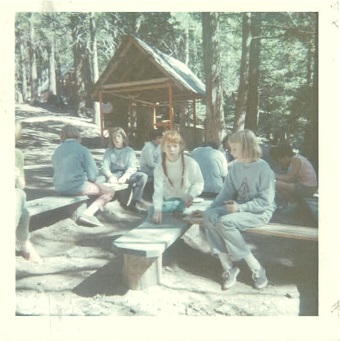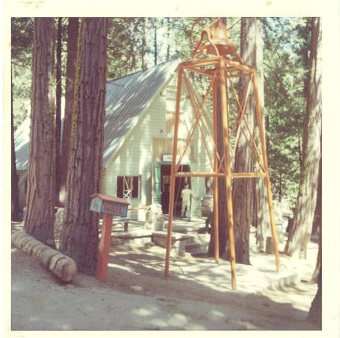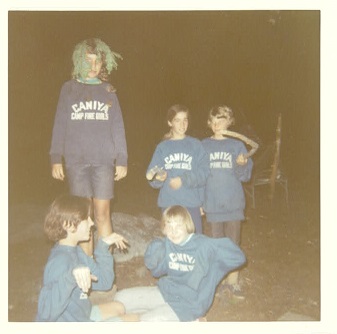On my desk I have the 1966 Directory of Accredited Camps for Boys and Girls published by the American Camping Association. I used this directory when applying for summer jobs many years ago. Yenis Hante was a small camp with a relatively short season of only five weeks. I wanted to work as a camp counselor for at least two months. At Yenis Hante I had met counselors who had worked at other camps and sometimes had jobs lined up for the month of August after Yenis Hante closed.

In 1966 California had twenty-one Camp Fire Girls’ resident camps accredited by the American Camping Association. (Now the American Camp Association) They spread north from Camp Wolahi, the San Diego camp near Julian, to Camp Kimtu in Humboldt County and east into the Sierra Nevada Mountains
Using ACA directories from libraries along with the earlier Sargent handbooks I have collected data about Camp Fire Girls’ camps during the last century . However, directories and handbooks were not available for every year, and camps were not always accredited. Also, sometimes there were errors and discrepancies from one directory to another, such as the year a camp was established. In 1967 we assumed Yenis Hante was opened in 1927 because that date was on the bell; later newspaper research showed that Yenis Hante opened in 1930. Camp Kimtu is not in the 1966 directory but an article in the Times Standard (Eureka, California) for August 14, 1967 reports “Camp Fire Sessions Under Way at Kimtu.” A year later the Eureka Camp Fire Council offered the 364 acre camp site to the county for $4,500 because they had found that sending girls by bus to a camp in Mendocino County would be less expensive than continuing to maintain their own camp. [1]

During the twentieth century there were more than three score Camp Fire Girls’ camps in California. Some of these, for example Mawahua and Woape, were ephemeral, listed only once in The Handbook of Summer Camps or a newspaper article. There might have been others which left no record at all.
In 1915 Los Angeles introduced the concept of municipal summer camps. These city- owned and operated camps in national forests were available to families and to groups such as the Camp Fire Girls. Usually a camp had a kitchen, an open air dining room, an assembly hall and cabins or tents on platforms. By 1921 Oakland, Sacramento and Stockton each had a municipal camp and Lost Angeles had two. Camp Seeley, owned by Los Angeles, and the Oakland camp were both used by Camp Fire Girls for a summer or two. [2] Camp Fire Girls also used camps belonging to other groups such as the YWCA’s Camp Estelle in the San Bernardino Mountains, the “Kiddie Camp” at Glennville and Boy Scout camps.
Just over a dozen of the sixty camps, mostly sponsored by San Francisco Bay area or Los Angeles area Camp Fire councils, operated for fifty years or longer. Those with the longest time spans are Nawakwa, Wolahi, Gold Hollow, Wastahi, Wasewagan, Minaluta and Minkalo. Other long-lived camps were Celio, Yallani, Augusta, Metaka and Okizu.
California is blessed with magnificent mountains. The San Bernardino Mountains, Sierra Nevada, and coast ranges have all been the summer homes of California’s Camp Fire Girls. Camps in the Sierra Nevada include Me-Wa-Hi near Sattley, Nawata near Placerville, Yenis Hante at Greenhorn Mountain, Minkalo in Amador County, Caniya in Sierra County and the camps around Lake Vera, near Nevada City, Augusta, Gold Hollow, Celio, Watanda, Okizu and Minaluta. A newer camp, Adahi, is located near Oakhurst. A number of Los Angeles area camps have been located in the San Bernardino Mountains; these include Wasewagan, Nawakwa, Li Tanda and Yallani near Seven Oaks, Metaka, Hemohme and Deer Ridge near Wrightwood, Wintaka at Running Springs, Cohila at Big Bear Lake, and the elusive Mawahua.

Other camps have been located up and down the coast. One of the earliest was Wasibo, a San Francisco camp located in the Santa Cruz Mountains. Pacific Palisades in the Santa Monica Mountains was the location of at least two camps, Temescal and Wasewagan. Wasewagan later moved to Seven Oaks. Camp Wa-Sta-Hi was located in Big Basin, south of San Jose and Campbell.
Although it did not yet have a permanent site Camp Minkalo was founded in 1919 making it California’s first Camp Fire Girls’ camp. The number of camps increased during the 1920s and through the depression and World War II. At the end of World War II there were more than twenty and by 1960 there were nearly thirty. In the 1960s camps began to close but there were still at least twenty-five in 1970. They continued to close through the rest of the century until there were only six in the year 2000. Today, in 2016, Wintaka, Adahi, Gold Hollow, Natoma and Nawakwa are the only resident camps in California listed on the National Camp Fire web page. I can only feel sad when I think of the mountain days that many of today’s children are missing.
[1] “County May Acquire Kimtu Site for Park” Times Standard (Eureka, California) July 25, 1968, p. 15. The Mendocino County camp is not named but might have been Seabow, near Laytonville, about 45 miles south of Camp Kimtu.
[2] “Municipal Summer Camps of the West” New York Times January 16, 1921, p. R7; Swenson, Stella S. One Hundred Years at Sliver Lake – Amador County: 1848-1948 – The Swenson Team (Bert & Stella), A Report Presented to Doctor Rockwell D. Hunt, Director of California History Foundation, College of the Pacific, April 1948, page 48.
Camp Seabow was near Laytonville ,on the Eel River. Now,June 2016; 50+ years later we are having Seabow reunions and singing camp songs. Once you’ve been to Summer camp, you NEVER forget !
LikeLike
I am 60+ years old and still every time I am driving in the mountains the smell takes me back to the 1960’s when I attended Camp Minaluta. These memories always make me smile and I find myself singing the camp theme songs (which I still remember). It makes me so sad that today’s kids will just not have the same opportunities to make these so precious memories.
LikeLike
I worked at Camp Yallani in San Bernardino for the summers of 1974, 1975, and 1976. Great Memories of the Counselors I worked with and the girls that came each week !
LikeLike
Y’all ani was awesome. I was there in 1963, 64, and 65. Super memories as a counselor. We had a burro named Christmas
LikeLike
I live in Michigan about 15 minutes away from Camp Wathana…where I spend most of my childhood in the 70s with my best friend (48+years now) and her mother as our Bluebird & CFG leader. Still in contact with many of our original troop, we did have a reunion about 5 years ago rehashing some of the greatest childhood memories we all ever had. Wo He Lo ❤
LikeLike
I loved Camp Caniya! Returned every summer for 5 years. I can still smell the vanilla pines. I brought a piece of bark home for my Mom to smell, but the smell was gone. The counselors were wonderful! I’m 56 now, live SC.
“We’re up at Caniya the camp of our dreams…🎶
LikeLike
I remember attending Camp Wetachi (I might not be spelling it properly) in the 1970s. I remember a lovely older counselor, a retirement age lady we called Miss Rosalie, who taught us how to make ojos de Dios out of popsicle sticks and yarn.
LikeLike
Does anyone remember Camp Caula in Castaic California.
LikeLike